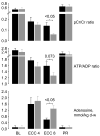Targeting mitochondria for resuscitation from cardiac arrest
- PMID: 20449908
- PMCID: PMC2865162
- DOI: 10.1097/ccm.0b013e31818a89f4
Targeting mitochondria for resuscitation from cardiac arrest
Abstract
Reversal of cardiac arrest requires reestablishment of aerobic metabolism by reperfusion with oxygenated blood of tissues that have been ischemic for variable periods of time. However, reperfusion concomitantly activates a myriad of pathogenic mechanisms causing what is known as reperfusion injury. At the center of reperfusion injury are mitochondria, playing a critical role as effectors and targets of injury. Studies in animal models of ventricular fibrillation have shown that limiting myocardial cytosolic Na+ overload attenuates mitochondrial Ca2+ overload and maintains oxidative phosphorylation, which is the main bioenergetic function of mitochondria. This effect is associated with functional myocardial benefits such as preservation of myocardial compliance during chest compression and attenuation of myocardial dysfunction after return of spontaneous circulation. Additional studies in similar animal models of ventricular fibrillation have shown that mitochondrial injury leads to activation of the mitochondrial apoptotic pathway, characterized by the release of cytochrome c to the cytosol, reduction of caspase-9 levels, and activation of caspase-3 coincident with marked reduction in left ventricular function. Cytochrome c also "leaks" into the bloodstream attaining levels that are inversely proportional to survival. These data indicate that mitochondria play a key role during cardiac resuscitation by modulating energy metabolism and signaling apoptotic cascades and that targeting mitochondria could represent a promising strategy for cardiac resuscitation.
Figures










Similar articles
-
Cerebral and myocardial mitochondrial injury differ in a rat model of cardiac arrest and cardiopulmonary resuscitation.Biomed Pharmacother. 2021 Aug;140:111743. doi: 10.1016/j.biopha.2021.111743. Epub 2021 May 18. Biomed Pharmacother. 2021. PMID: 34020243
-
Limiting sarcolemmal Na+ entry during resuscitation from ventricular fibrillation prevents excess mitochondrial Ca2+ accumulation and attenuates myocardial injury.J Appl Physiol (1985). 2007 Jul;103(1):55-65. doi: 10.1152/japplphysiol.01167.2006. Epub 2007 Apr 12. J Appl Physiol (1985). 2007. PMID: 17431086
-
Circulating levels of cytochrome c after resuscitation from cardiac arrest: a marker of mitochondrial injury and predictor of survival.Am J Physiol Heart Circ Physiol. 2007 Feb;292(2):H767-75. doi: 10.1152/ajpheart.00468.2006. Epub 2006 Oct 13. Am J Physiol Heart Circ Physiol. 2007. PMID: 17040974 Free PMC article.
-
Sodium-Hydrogen Exchanger Isoform-1 Inhibition: A Promising Pharmacological Intervention for Resuscitation from Cardiac Arrest.Molecules. 2019 May 7;24(9):1765. doi: 10.3390/molecules24091765. Molecules. 2019. PMID: 31067690 Free PMC article. Review.
-
delta-Opioid-induced pharmacologic myocardial hibernation during cardiopulmonary resuscitation.Crit Care Med. 2006 Dec;34(12 Suppl):S486-9. doi: 10.1097/01.CCM.0000246015.05214.5A. Crit Care Med. 2006. PMID: 17114982 Review.
Cited by
-
Neuroprotective Treatment of Postanoxic Encephalopathy: A Review of Clinical Evidence.Front Neurol. 2021 Feb 18;12:614698. doi: 10.3389/fneur.2021.614698. eCollection 2021. Front Neurol. 2021. PMID: 33679581 Free PMC article. Review.
-
AVE4454B--a novel sodium-hydrogen exchanger isoform-1 inhibitor--compared less effective than cariporide for resuscitation from cardiac arrest.Transl Res. 2011 Feb;157(2):71-80. doi: 10.1016/j.trsl.2010.11.004. Epub 2010 Dec 15. Transl Res. 2011. PMID: 21256459 Free PMC article.
-
Hypothermia-induced neuroprotection is associated with reduced mitochondrial membrane permeability in a swine model of cardiac arrest.J Cereb Blood Flow Metab. 2013 Jun;33(6):928-34. doi: 10.1038/jcbfm.2013.33. Epub 2013 Mar 13. J Cereb Blood Flow Metab. 2013. PMID: 23486294 Free PMC article.
-
Protecting mitochondrial bioenergetic function during resuscitation from cardiac arrest.Crit Care Clin. 2012 Apr;28(2):245-70. doi: 10.1016/j.ccc.2012.02.001. Crit Care Clin. 2012. PMID: 22433486 Free PMC article. Review.
-
Impaired cerebral mitochondrial oxidative phosphorylation function in a rat model of ventricular fibrillation and cardiopulmonary resuscitation.Biomed Res Int. 2014;2014:192769. doi: 10.1155/2014/192769. Epub 2014 Feb 18. Biomed Res Int. 2014. PMID: 24696844 Free PMC article.
References
-
- Rosamond W, Flegal K, Furie K, Go A, Greenlund K, Haase N, Hailpern SM, Ho M, Howard V, Kissela B, Kittner S, Lloyd-Jones D, McDermott M, Meigs J, Moy C, Nichol G, O’Donnell C, Roger V, Sorlie P, Steinberger J, Thom T, Wilson M, Hong Y. Heart disease and stroke statistics--2008 update: a report from the American Heart Association Statistics Committee and Stroke Statistics Subcommittee. Circulation. 2008;117:e25–146. - PubMed
-
- Sans S, Kesteloot H, Kromhout D. The burden of cardiovascular diseases mortality in Europe. Task Force of the European Society of Cardiology on Cardiovascular Mortality and Morbidity Statistics in Europe. Eur Heart J. 1997;18:1231–1248. - PubMed
-
- Brown CG, Martin DR, Pepe PE, Stueven H, Cummins RO, Gonzalez E, Jastremski M the Multicenter High-Dose Epinephrine Study Group. A comparison of standard-dose and high-dose epinephrine in cardiac arrest outside the hospital. N Engl J Med. 1992;327:1051–1055. - PubMed
-
- Kellermann AL, Hackman BB, Somes G. Predicting the outcome of unsuccessful prehospital advanced cardiac life support. JAMA. 1993;270:1433–1436. - PubMed
-
- Lombardi G, Gallagher J, Gennis P. Outcome of out-of-hospital cardiac arrest in New York City. The pre-hospital arrest survival evaluation (PHASE) study. JAMA. 1994;271:678–683. - PubMed
Publication types
MeSH terms
Substances
Grants and funding
LinkOut - more resources
Full Text Sources
Medical
Research Materials
Miscellaneous

